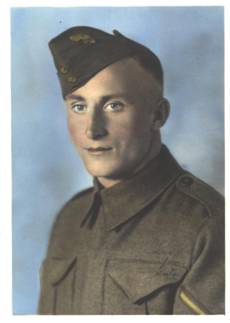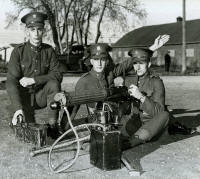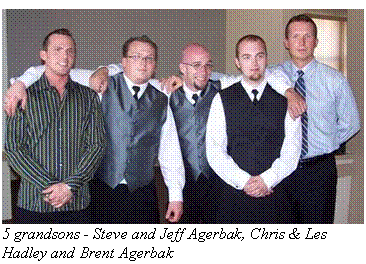Borge Agerbak

submitted by Carol Hadley
Borge (Buster) Agerbak was born March 21, 1914 in Odense, Denmark, the eldest son of Anton Agerbak and Kamma Moeller. The Agerbaks chose Canada as their new home in 1927 and settled in the Pilot Mound, Manitoba area with all five children: brothers Borge (Buster), Tage (Tiger) and Knud (Ken) and sisters Anne and Margaret. The family farmed in this area for many years prior to the war. Borge, the oldest, helped support the family by working in various jobs. Besides farming he worked as a lumberjack, a construction worker on the Great Falls Generating Station as well as a miner in Bissett. Tage, the second oldest, was married and had two small children living in Pilot Mound when war was declared. Ken, the youngest was not long out of school and was living at home. The three brothers enlisted in the Winnipeg Grenadiers September 1939. In March 1940 at a St. Patrick’s Dance in Winnipeg, Borge met Evelyn White and after he was shipped out to Bermuda and Jamaica they corresponded regularly.
May 24, 1940 the Winnipeg Grenadiers left for Halifax to sail to Bermuda and Jamaica. Here they relieved British troops, who were needed in Europe for the war effort. By doing so they guarded German prisoners including those sailors who were taken from the Graf Spey after it was scuttled off the shores of Uruguay. While in Bermuda and Jamaica, there was a little training but very sporadic as there were insufficient weapons and ammunition was scarce.
 October 1st
the Winnipeg Grenadiers became one of the regiments, along with the
Royal Rifles of Canada and a Headquarters Brigade, to form ‘C’ Force.
October 1st
the Winnipeg Grenadiers became one of the regiments, along with the
Royal Rifles of Canada and a Headquarters Brigade, to form ‘C’ Force.
October 11, 1941 the Winnipeg Grenadiers returned to Canada. Borge married Elizabeth Evelyn White on October 18, 1941 in Winnipeg.
October 27 the newly formed ‘C’ Force with many new recruits, was sent to Victoria to board the Prince Robert and the Awatea ships that took them to Hong Kong.
Evelyn was not able to contact Borge for almost four years that were full of uncertainty as to his well-being. She kept busy working at Trans-Canada Airlines as a riveter, helping to build planes for Britain – her contribution to the war effort.
Borge was in ‘A’ Company that fought at Mount Nicholson, Bennett’s Hill, Wong Nei Cheong Gap, and Jardine’s Lookout where he was wounded (shot in the left leg and lots of shrapnel in the face and upper body) before being captured by the Japanese.
When the Japanese pushed the mainland troops back from the Gin Drinkers Line, the battle moved to the island where it intensified. There was great confusion due to a lack of communication, misinformation and that many of the officers, who had previous experience in fighting in WWI, were killed. There seemed to be little strategy in the fighting from lack of training for the Canadians and the fact that the British were unable to believe that the Japanese would actually attack them. As the Canadians did not have all their transportation, ammunition and supplies arrive with them, they were greatly challenged with their resources.
At one point, ‘A’ Company was sent to Mt Butler to reinforce ‘D’ Company and they were surrounded and running short of ammunition and food. Borge and about 8 or 10 others, a rag-tail group of Grenadiers, Rifles, Scots, Rajputs and Punjabis who were separated from their units while fighting, formed their own unit trying to find the Police Station where they had heard ammunition and food might be available. It took many hours of fighting and trying to out-manoeuvre the Japanese before they arrived at the Police Station - only to find that the information was incorrect. They began a return trip through all the action again in an attempt to reach what was left of their troops. Somewhere along the way a bullet in the left knee injured Borge. They were on Bennett’s Hill and took refuge in a bunker. It was here that Borge met up with John (Jesse) James. Shortly after his arrival a grenade was dropped down an airshaft and exploded. As the men rushed the door another grenade blew open the door and killed many of the men inside. When the first grenade exploded, Borge was knocked to the floor and stunned. After the second exploded he and John, who were still able, climbed out to fight their way back down the hill. This action occurred at Jardine’s Lookout. The two of them scrambled down a ravine, with a creek running through it, trying to stay hidden from the Japanese. John, could see but had part of his leg blown off and couldn’t walk with out assistance and Borge, although with a leg wound, could still walk but couldn’t see as he had many lacerations in the face from the shrapnel. They eluded the Japanese for only a short while before they were captured.
After 17 days of heavy fighting, little rest, little food and water, the battle ended. December 25, 1941 was the surrender of Hong Kong and Borge was in the Queen Mary Hospital where their medical corp. patched up his injuries. He spent time in North Point and Sham Shui Po Camps where he was involved in working on the Kai Tak Airport. He was able to find his brother Knud (Ken) but they were unable to find any information on Tage (Tiger). Borge experienced the effects of many tropical diseases like Beri Beri, Diphtheria, Malaria, Dysentery, and malnutrition, from the lack of sufficient food and medicine at the hands of the Japanese. The slave labour took its toll on many of the men as they were beaten and food was withheld if their captors thought they were not working hard enough.
January 24, 1943 he was sent to Japan to Camp 5D where he was made to work on shipbuilding for the Japanese. The trip by boat was terrible as there were about 300 men suffering from various tropical diseases, with little food and no room to move or lay down. They were not allowed topside of the ship so they had to use buckets in the hold for relieving themselves. The buckets were then hoisted up, with the contents slopping over the side and eventually emptied over the side of the boat. There was no accommodation for showering or bathing and many men just had the clothes on their backs. By the time they arrived in Japan the men were a pretty disgusting mess and very smelly. The Japanese took them to an area to clean them up and debug them and issued them with new clothing (Japanese style). As most of these men were much taller than their captors, the clothing was and looked ridiculous. The Japanese were petitioned by the prisoners to have the clothing altered. Borge and Ken Gaudin volunteered for the task of repairing some old Singer sewing machines and altering the clothing. This new job helped Borge as he had trouble seeing the rivets that were being thrown to him as he was working on the ships. Every time he missed catching a rivet a Japanese guard beat him. Ken had been badly wounded in the shoulder and it was difficult for him to hold the can to catch the rivet while using the riveter in the other hand. So this new job saved them many beatings and they altered the clothing to fit the prisoners as well as made some shoes from scraps that they found.

From April 10, 1943 - October 28, 1943 Borge was in and out of hospital due to diphtheria, Beri Beri, malaria and pneumonia. He had extreme weight loss from the 180 lbs at enlistment to 110 – 112 lbs that he weighed in Japan.
In February or March of 1944 Borge, and several others from Camp 5D, were sent by train to a northern mining camp. Here they dug coal with antiquated picks and shovels, loaded the cars and pushed them up a couple of hundred feet out of the shaft to be loaded into rail cars for the Japanese to fuel their ships. They would work 10-hour days for 8 or 9 days at a time before a day off with their only sustenance being 1½ cups of rice and a cup of watery soup 3 times a day. As their location was further north the climate was colder and the men had insufficient clothing or bedding to keep them warm. They slept on tatami mats infested with lice on concrete or bare ground. They were allowed a few bits of coal but that was barely enough to cook their food so there was none left over to heat their rooms. Many men developed pneumonia and died due to these extreme conditions.
Borge maintained the reason he and others survived such terrible conditions was the fact that they never gave up, had a strong belief in God and had a sense of humour. The bonds this band of brothers share are deeper than a blood relation and is still present among the survivors today. They lived from day to day with the belief that a rescue would come. As it did in August of 1945 when they heard the rumble and felt the ground shake from the atomic bomb that hit Nagasaki. A few days later American planes flew over and dropped leaflets to say they would return with food and supplies, which they did. Over the decades there has been much controversy over the atomic bomb but all of the POW’s knew that they would have been killed if there had been an invasion by land. This was proven at the Nara War Crimes Trial with documents written by the Japanese military.

The POW’s made their way back to Tokyo where they were picked up by American ships and taken to Guam where they were checked over by medical personnel. They received a debriefing by the US military and were marshalled into areas specific to their needs. After a short time Borge was back on ship to San Francisco only to be rechecked by medical people and again debriefed. He was then sent on a train to Vancouver where he received a Canadian uniform, another medical check and debriefing by Canadians. When the men told their story to the military officials, they were not believed because the horrific treatment they received by the Japanese was unheard of due to the Geneva Convention documents to protect prisoners of war. It was due to the disbelief that these men refused to discuss the events of the war except with one another.
The medical check detained Borge for a short time due to some health issues but soon he was on the train for home. October 24, 1945, four years later, he arrived in Winnipeg and was welcomed home by his wife and family.
For the balance of his life there were residuals from his war experience as he had many operations on his leg trying to restore it. There were nightmares and re-occurrences of malaria that were hard for his wife and family to share with him. He had an abnormal heart flutter that sometimes was a concern to his doctors. But with all the issues, he was a survivor and managed to stay with the same wife for fifty-seven years, have two children and five grandsons.
Upon his return, Borge didn’t talk about his experiences of the war until later years. The memories were too horrific and painful. When his children were in high school and doing history projects he gave a little insight to his ordeal. It wasn’t until a pilgrimage to Hong Kong and Japan in 2000 with his daughter, son and their spouses that he related more of his experiences.
Borge was a long time member and executive of the Hong Kong Veterans’ Association and more recently a member of the Hong Kong Veterans Commemorative Association. He was a member of many Masonic organizations and held executive positions with them all; some of them are: Red River Lodge #172, Corinthian Lodge #178, Quatour Coronati Lodge #2076, and the concordant York Rite bodies. He was also associated with the Order of DeMolay, Job’s Daughters, Eastern Star and the Khartum Shrine, for many years.
Borge was a member of the United Church of Canada. He enjoyed gardening, reading and travelling. He retired from the Federal Civil Service in 1973 after 27 years and received the Canadian Centennial Medal from the Prime Minister in 1967. He passed away May 1, 2001.

Bill and Janie Agerbak, Carol and Al Hadley
